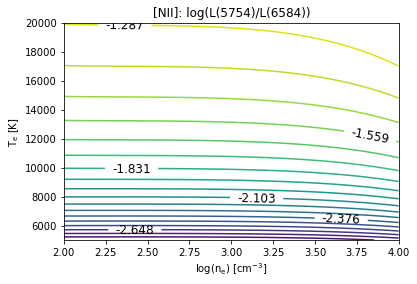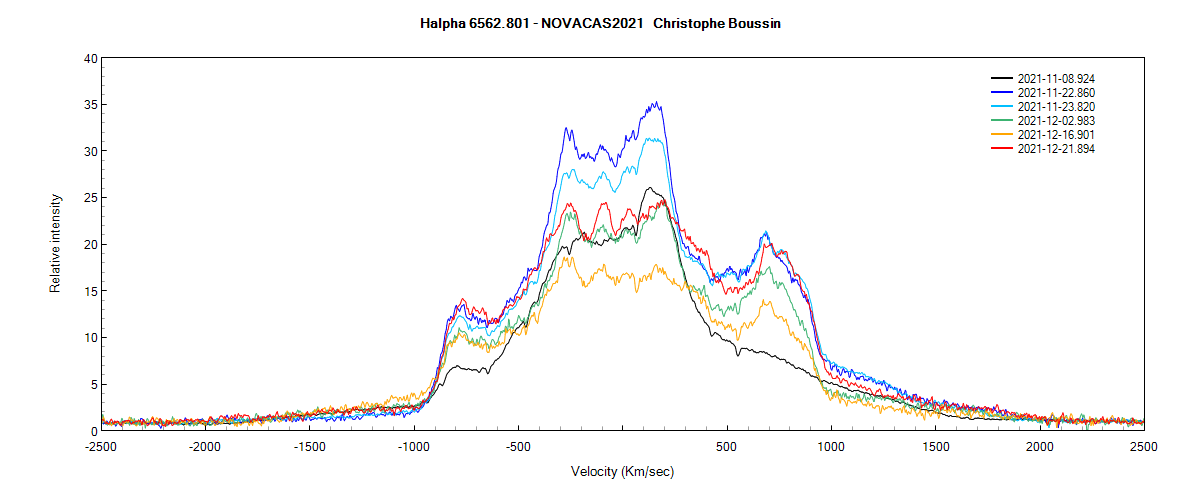Page 12 of 13
Re: Alert! Nova Cas 2021 mag 9
Posted: Sat Dec 04, 2021 9:40 am
by Francois Teyssier
From recent spectra secured by Joan Guarro, [NII] 6583 is rising in the red edge of H alpha.
6548 is very weak. The theoretical ratio 6583/6548 is ~ 3 and in the blue part of H alpha absorption are still important.

- NovaCas2021_NII.PNG (107.37 KiB) Viewed 6674 times
I propose the following question:
why [NII] 5755 is intense and [NII] 6583, 6583 are still very weak?
François
Re: Alert! Nova Cas 2021 mag 9
Posted: Sun Dec 05, 2021 2:46 am
by James Ley
Good question François,
Is it because the electron temperature is still too high?
The 5755 line is produced by transition from a higher energy ¹S level than the ¹D level that produces the 6583 and 6548 lines. So if the electron temperature is still very high, the higher level (¹S) would be much more populated than the lower level (¹D). The result would be [NII] 5755 (¹S to ¹D) is intense and [NII] 6583, 6548 (¹D to ³P) are still very weak.
Re: Alert! Nova Cas 2021 mag 9
Posted: Sun Dec 05, 2021 10:30 pm
by James Ley
After re-reading Osterbrock page 109, the longer lifetime of the 1D term could result in selectively more collisional de-excitation, thus weakening the 6583 and 6548 lines.
Perhaps both density and electron temperature are important in this situation.
Re: Alert! Nova Cas 2021 mag 9
Posted: Mon Dec 06, 2021 4:29 pm
by Francois Teyssier
Yes, James, this is the good way.
In your first analysis, only electronic temperature was taken into account.
This is the case in the low density approximation (HI regions, planetaries nebulae -but not all-, classical novae in late nebular phase ...)
say when the Ne is < 10^4: the Ne term can be neglected.
In this case: the ratio 5575/6584 is almost independant of the electronic density with horizontal lines.

- N2.png (38.51 KiB) Viewed 6566 times
In its current state, the ejecta of Nova Cas 2021 is still optically very thick (as seen with the absorption components of the low members of the Balmer lines) and the electronic density is high and cannot be neglected.
As you mention we must take it in account.
The same diagnostic diagram, but for a wider range of Ne:

- N2a.png (56.32 KiB) Viewed 6566 times
Due to the high Ne, the level 4 is depopulated essentially by electronic collisions *before* it can produce a desexcitation by radiation to level 3: the lines 6548, 6584 are very weak or even absent.
The critical density of level 5 is much higher, thus desexcitation by radiative transfert to level 3 can happen.
Critical densities of the [NII] levels:
Level Critical densities
Level 1: 0.000E+00
Level 2: 3.814E+01
Level 3: 2.382E+02
Level 4: 8.865E+04
Level 5: 1.636E+07
Level 6: 9.019E+09
The current intensities of NII lines allow a rough estimation of the electronic density: between 10^5 and 10^7 cm^-3.
François
Re: Alert! Nova Cas 2021 mag 9
Posted: Wed Dec 08, 2021 2:15 am
by James Ley
Thank you for that wonderful explanation François.
I had a hard time understanding the definition of critical density given by Osterbrock and Ferland. For me, their definition was more opaque than this optically thick nova.
Re: Alert! Nova Cas 2021 mag 9
Posted: Sun Dec 12, 2021 1:44 pm
by Joan Guarro Flo
Hello,
That is a general view of Nova Cas 2021 this last night, from SMM Obs.
J.Guarro.
Nova Cas 2021 evolution in an Alpy spectroscope
Posted: Tue Dec 14, 2021 9:05 am
by HughAllen
In spite of the English weather I have now captured 33 Alpy spectra of Nova Cas 2021, available in the ARAS and BAA databases. It is interesting to highlight the timing of the observations on the light curve from Vmag data in the AAVSO database:

- Annotated light curve.png (45.62 KiB) Viewed 6330 times
When compared as a stacked, offset plot then I think the spectra paint an equally interesting story. To help resolve some of the detail I split the plots into two wavelength ranges and cropped the y-axis. The spectra are normalised at 5550-5560A and offset by 0.3, the first spectrum on March 22 at the bottom and the last spectrum on December 06 at the top. The spectrum captured near maximum brightness on May 10 is highlighted in red. I think I have the emission lines correctly identified but would welcome feedback on that:

- Stacked crop 3800-5800 annotated.png (182.65 KiB) Viewed 6330 times

- Stacked crop 5800-7730 annotated.png (162.98 KiB) Viewed 6330 times
The explosion velocity can be estimated from the P Cygni profiles on many of the emission lines. The inverse relationship between the velocity and brightness of the nova, already commented on by many amateurs, can be clearly seen:
Cheers
Hugh
Re: Alert! Nova Cas 2021 mag 9
Posted: Sat Dec 18, 2021 11:52 am
by Joan Guarro Flo
Hello,
Good job Hugh!
That is a view of Nova Cas 2021 from last 15th December.
Cheers, J. Guarro.
Re: Alert! Nova Cas 2021 mag 9
Posted: Sun Dec 19, 2021 9:59 am
by Joan Guarro Flo
Hello,
Nova Cas 2021 last night.
J.Guarro.
Re: Alert! Nova Cas 2021 mag 9
Posted: Fri Dec 24, 2021 1:19 pm
by Christophe Boussin
Hello all,
Great jobs Hugh and Joan !!
I obtained three new high resolution spectra of the Halpha line on December 2 at 23 h 35 TU (resolution of 15203, JJ = 2459551.4825, 6 x 600s), on December 16 at 21 h 37 TU (resolution of 18441, JJ = 2459565.401, 6 x 600s) and on December 21 at 21 h 27 TU (resolution of 18732, JJ = 2459570.3941, 11 x 600s) with my LHIRES III (grating of 2400 lines / mm).
Here are all the spectra obtained between November 8th and December 21th :

- Halpha line profile of the Nova CAS 2021 (zero velocity is on Halpha at rest) on November 8th, 22th, 23th and on December 2nd, 16th and 21th 2021
- novacas2021_Halpha_Christophe Boussin.png (74.95 KiB) Viewed 5959 times
The visible structures in the Halpha line profile and the relative intensities of the nitrogen forbidden lines [NII] continue their evolution.
According to the AAVSO website, the decline of the Nova continues with a magnitude now close to 10 !
(Johnson V : green squares)

- Light curve of the Nova CAS 2021 (AAVSO)
Merry Christmas and clear skies to all of you !!
Christophe BOUSSIN